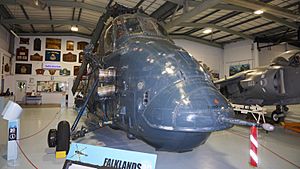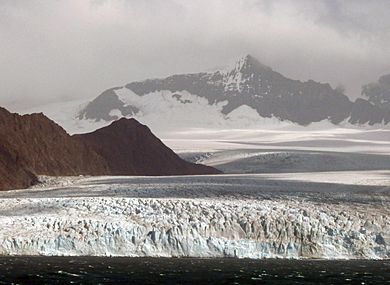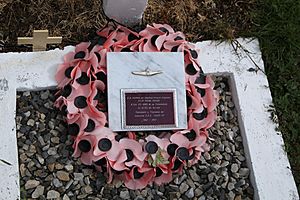Operation Paraquet facts for kids
Quick facts for kids Operation Paraquet |
|||||||
|---|---|---|---|---|---|---|---|
| Part of the Falklands War | |||||||
 Antrim's Wessex HAS3, nicknamed "Humphrey", preserved at the Fleet Air Arm Museum], played a crucial role in the operatioon |
|||||||
|
|||||||
| Belligerents | |||||||
| Commanders and leaders | |||||||
|
|
||||||
| Strength | |||||||
|
|
||||||
| Casualties and losses | |||||||
| 2 helicopters |
|
||||||
Operation Paraquet was a secret mission by the British military at the start of the Falklands War in April 1982. Its goal was to take back the island of South Georgia from Argentine forces. This operation was a smaller part of a bigger plan called Operation Corporate, which aimed to recapture the Falkland Islands themselves. Operation Paraquet was a success! South Georgia was returned to British control on April 25, 1982. The mission was officially named "Paraquet," like the bird, but British soldiers often called it "Paraquat," after a strong weedkiller.
Contents
Why Was Operation Paraquet Needed?
The British government wanted to show they were serious about defending their territory. So, Admiral John Fieldhouse ordered this mission. The plan was put together by experts at 3 Commando Brigade.
Major General Jeremy Moore of the Royal Marines was asked to prepare a special group of soldiers. They chose a company from 42 Commando, who were used to cold weather training in Norway. Major Guy Sheridan, who was good at mountaineering, led this group. His team included 132 men, with specialists like medics and signallers.
Sheridan also asked for help from the Royal Marine Mountain and Arctic Warfare Cadre. Instead, they got a group from the Special Air Service (SAS) from Ascension Island. This included different SAS troops, like those good with boats or in the air. Also, two troops from the Special Boat Service (SBS) joined the mission.
Journey to South Georgia
The ships carrying these troops left Ascension Island on April 11. There were many soldiers on board, making space tight. The main ships included the tanker RFA Tidespring, the frigate HMS Plymouth, and the destroyer HMS Antrim. A submarine, HMS Conqueror, also joined the group. This entire force was called Task Force South Georgia and was led by Captain Brian Young from Antrim.
On April 14, the task group met with HMS Endurance. The next day, they received their written orders for the operation. These orders, dropped by an RAF Nimrod aircraft, set the landing date for April 21.
Scouting the Enemy

The submarine Conqueror arrived first on April 18. It secretly checked out important parts of the coast. Then, it moved away to watch for any Argentine navy ships.
The British needed to find out where the Argentine forces were. They didn't know how many soldiers Argentina had on the island. The plan was for SBS patrols to land at Hound Bay. From there, they would travel to a lookout point at Brown Mountain, which overlooked Grytviken.
The SAS had a more daring plan. They wanted to use helicopters to land on Fortuna Glacier, about 8 miles west of Stromness. From the glacier, they would scout several areas like Leith Harbour and Stromness. The SAS chose the glacier because it was far from enemy positions. They thought the Argentines wouldn't expect an attack from that direction.
However, some officers, like Captain Nick Barker of Endurance, warned that traveling on the glacier would be very hard. But Major Cedric Delves, the SAS commander, decided to go ahead with the plan.
On April 20, an RAF Victor plane flew a long reconnaissance mission over the South Atlantic, including South Georgia. On the same day, the Task Force reached its destination.
Challenges on Fortuna Glacier
The next day, 15 SAS men were flown onto Fortuna Glacier by two Wessex helicopters. They immediately faced terrible weather. Winds reached 100 mph, and temperatures were freezing. Deep crevasses made it hard to move. Their tents were even blown away by the wind.
After 15 hours, the SAS leader asked to be rescued. Three Wessex helicopters were sent. After a difficult attempt, they found the SAS men. But in whiteout conditions, one helicopter crashed. The men got into the other two helicopters. Soon after, another helicopter hit a ridge and crashed, but again, no one was seriously hurt.
The last Wessex, from Antrim, went back to rescue the downed SAS and aircrew. The pilot, Lieutenant Commander Ian Stanley, managed to fly his overloaded helicopter back to Antrim. He made an emergency landing and was later honored for his bravery.
SBS Patrols Face Difficulties
The SBS patrols also faced problems. On April 22, four SBS men landed at Hound Bay. Local scientists told them there were no Argentines there. The next day, strong winds stopped more SBS men from landing by helicopter. Endurance had to get very close to the coast to land them using inflatable boats.
After spending a night at Dartmouth Point, the SBS moved towards Nordenskjöld Glacier. A helicopter brought in two inflatable boats, but one was damaged. They used the other boat to cross part of Cumberland Bay East. But strong winds and ice from the glacier stopped them. The mission was called off, and the SBS had to wait another day to be picked up.
On April 22, the tanker RFA Brambleleaf joined the Task Force. It had been damaged in a storm. They decided to transfer its fuel to Tidespring before Brambleleaf returned to the UK for repairs. This process was interrupted when an Argentine C-130 plane spotted the ships. The fuel transfer stopped because of a suspected Argentine submarine, Santa Fe, in the area.
Despite these problems, Captain Young still wanted to gather information. On the night of April 22/23, Antrim entered Stromness Bay. Another SAS group, the Boat Troop, tried to land in five inflatable boats. Two boats' engines failed, and they were swept out to sea by a sudden storm. One boat was rescued by Antrim's helicopter. The other managed to restart its engine and reach the shore.
The remaining three boats reached Grass Island. The men climbed a cliff in freezing conditions and set up a lookout post. They reported no Argentine activity in the Stromness area. They signaled for help, and HMS Endurance airlifted them out the next day. After this, the 17 Troop called themselves "The South Georgia Boating Club."
Attack on the Argentine Submarine Santa Fe

On April 23, the British learned that an Argentine submarine was nearing South Georgia. This was the Santa Fe, a Balao class boat. On April 9, Santa Fe had left Argentina with technicians and marines to reinforce the Argentine forces on South Georgia. This mission was approved by Admiral Jorge Anaya, the head of the Argentine Navy.
The submarine's sensors were not very reliable, and its old batteries didn't hold much charge. Santa Fe's orders were to stay hidden and not attack any ships. The arrival of the submarine was a big threat to the British Task Force. Captain Young ordered his ships to spread out, except for Endurance.
Antrim's helicopter crew thought Santa Fe would unload its troops in the dark and then leave Cumberland Bay at dawn without diving, because of icebergs. They suggested putting radar back on their Wessex helicopter to find Santa Fe as it left the bay. Captain Young moved his three warships about 25 miles north-east of Cumberland Bay. He prepared his helicopters for an anti-submarine attack.
At 08:55 on April 25, Antrim's Wessex helicopter found the submarine using radar. It attacked with depth charges. One charge hit the submarine, damaging its side and a fuel tank. The submarine could no longer dive. Its commander, Horacio Bicain, had to turn back towards Grytviken.
A Lynx helicopter joined the attack and fired a torpedo, but it missed. Then, Wasp helicopters fired AS-12 missiles. Endurance's Wasps were closer and could rearm and attack several times. As the submarine neared Grytviken, Argentine soldiers on shore fired at the helicopters. The submarine crew also tried to defend themselves with guns. The last missile caused the most damage, hitting the submarine's periscopes. By 11:00, the damaged Santa Fe was back at Grytviken pier, where its crew left it.
British Forces Take Action
With Santa Fe disabled, Major Sheridan believed the Argentines would be discouraged. He thought an attack should happen right away. However, his main force was still far away on Tidespring. So, a small, quick force was put together from the soldiers on Antrim. This group had 79 men, including Royal Marines and Special Forces.
Helicopters then launched an assault with these special forces and Royal Marines. Two Royal Navy ships, Antrim and Plymouth, fired their guns at the hills near Grytviken to show their power. The Argentine soldiers at Grytviken and the crew of the damaged Santa Fe surrendered after just 15 minutes, at 5:15 PM GMT. The Argentine commander at Leith Harbour, Lieutenant Commander Alfredo Astiz, surrendered the next day.
Sadly, an Argentine prisoner of war, Navy Petty Officer Felix Artuso, was accidentally shot on April 26. A British marine mistakenly thought he was trying to damage the submarine. He is buried at Grytviken Cemetery.
After the surrender at Grytviken, Captain Brian Young, the Task Group Commander, sent a famous message: "Be pleased to inform Her Majesty that the White Ensign flies alongside the Union Jack in South Georgia. God save the Queen."
When Secretary of State for Defence John Nott read this message, Prime Minister Margaret Thatcher told the crowd to "rejoice!"
Wildlife filmmaker Cindy Buxton and her assistant Annie Price, who had been filming on the island before the invasion, were safely taken off the island by a helicopter from HMS Endurance on April 30.



